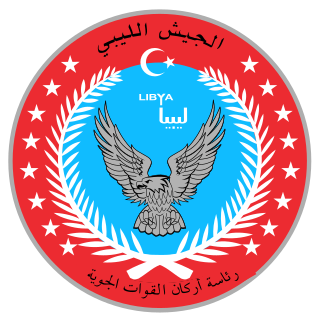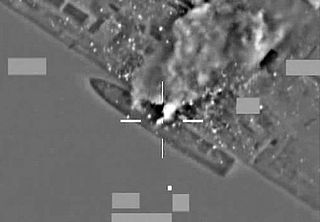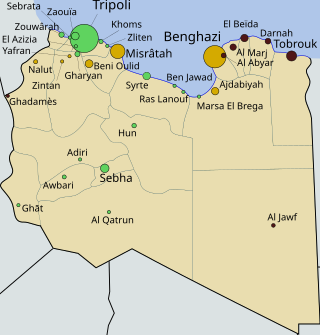
The Mikoyan-Gurevich MiG-21 is a supersonic jet fighter and interceptor aircraft, designed by the Mikoyan-Gurevich Design Bureau in the Soviet Union. Its nicknames include: "balalaika", because its planform resembles the stringed musical instrument of the same name; "Ołówek", Polish for "pencil", due to the shape of its fuselage, and "Én Bạc", meaning "silver swallow", in Vietnamese.

The Soko G-2 Galeb is a Yugoslav single engine, two-seater jet trainer and light ground-attack aircraft. The G-2 was developed during the 1950s by the Aeronautical Technical Institute at Žarkovo as a replacement for the Lockheed T-33 in service with the Yugoslav Air Force. Production started in 1965 at the Soko aircraft factory in Mostar, and ended in 1985 with 248 aircraft delivered. The G-2 had the distinction of being the first mass-produced jet aircraft in socialist Yugoslavia. It also served as a basis for the single-seat ground-attack J-21 Jastreb.

Benina International Airport serves Benghazi, Libya. It is located in the borough of Benina, 19 kilometres (12 mi) east of Benghazi, from which it takes its name. The airport is operated by the Civil Aviation and Meteorology Bureau of Libya and is the second largest in the country after Tripoli International Airport. Benina International is also the secondary hub of both Buraq Air and flag carrier, Libyan Airlines. As of 17 July 2014 all flights to the airport were suspended due to fighting in the area.

The Libyan Air Force is the branch of the Libyan Armed Forces responsible for aerial warfare. In 2010, before the Libyan Civil War, the Libyan Air Force personnel strength was estimated at 18,000, with an inventory of 374 combat-capable aircraft operating from 13 military airbases in Libya. Since the 2011 civil war and the ongoing conflict, multiple factions fighting in Libya are in possession of military aircraft. As of 2019 the Libyan Air Force is nominally under the control of the internationally recognised Government of National Accord in Tripoli, though the rival Libyan National Army of Marshal Khalifa Haftar also has a significant air force. In 2021, the air force is under command of the new President of Libya, Mohamed al-Menfi that replaced Fayez al-Sarraj.
This is a list of aviation-related events from 2011.

The battle of Misrata, also known as the siege of Misrata, was a battle of the 2011 Libyan Civil War for the control of Misrata. It was fought between troops loyal to the government of Muammar Gaddafi, and anti-Gaddafi rebels who held Misrata, the third largest city in Libya. Following the initial stages of the uprising, the Libyan government took back most towns in the west of the country, leaving Misrata the only major city under rebel control in Tripolitania. The city soon became the site of one of the war's major battles and the suffering of its citizens gained worldwide attention.

The National Liberation Army, officially the National Liberation Armed Forces of the Free Libyan Republic, formerly known as the Free Libyan Army, was a Libyan military organisation affiliated with the National Transitional Council, which was constituted during the First Libyan Civil War by defected military members and civilian volunteers, in order to engage in battle against both remaining members of the Libyan Armed Forces and paramilitia loyal to the rule of Muammar Gaddafi. Its self proclaimed chief commander was General Khalifa Haftar, although the National Transitional Council preferred to appoint Major General Abdul Fatah Younes Al-Obeidi as its commander-in-chief. It had prepared for some time in portions of Eastern Libya controlled by the anti-Gaddafi forces for eventual full-on combat in Western Libya against pro-Gaddafi militants, training many men before beginning to go on the offensive. They have battled for control of Benghazi, Misrata, Brega, Ajdabiya, Zawiya and Ra's Lanuf as well as several towns in the Nafusa Mountains. They finally began the Battle for Tripoli in August 2011 when they attacked from the west of the city, as well as fomenting an internal uprising on 20 August.

The First Battle of Brega was fought during the Libyan Civil War. It began when pro-Gaddafi government troops attacked the city, held by the National Transitional Council, in the early hours of 2 March 2011.
The Battle of Ras Lanuf was a two-phase battle in 2011 during the Libyan Civil War between forces loyal to Libyan leader Muammar Gaddafi and those loyal to the National Transitional Council. Both forces sought control of the town of Ras Lanuf. The first phase followed two days after the First Battle of Brega which occurred in the town Brega, roughly 130 kilometres (81 mi) to the east of Ras Lanuf. After conquering the town on 4 March, the rebels pushed further west to attack Sirte but they were driven back by government forces and on 11 March, government troops reconquered most of Ras Lanuf.
The Free Libyan Air Force was the air force of the National Transitional Council during the First Libyan Civil War. It was established by and was a collection of Libyan Air Force defectors with captured aircraft that aligned themselves with the anti-Gaddafi forces in the civil war.

Operation Ellamy was the codename for the United Kingdom participation in the 2011 military intervention in Libya. The operation was part of an international coalition aimed at enforcing a Libyan no-fly zone in accordance with the United Nations Security Council Resolution 1973 which stipulated that "all necessary measures" shall be taken to protect civilians. The coalition operation was designated by NATO as Operation Unified Protector, by the US as Operation Odyssey Dawn. The Canadian participation as Operation Mobile and the French participation as Opération Harmattan. It was confirmed in December 2011 that the cost of the operations was £212m – less than was estimated, including £67m for replacing spent munitions, is all expected to be met from the Treasury reserve.

The Second Battle of Benghazi took place during the Libyan Civil War between army units and militiamen loyal to Libyan leader Muammar Gaddafi, and anti-Gaddafi forces in Benghazi. The battle marked the start of a United Nations-mandated military intervention in the conflict, with fighter jets from the French Air Force attacking and destroying several pro-Gaddafi units, forcing them to retreat.

Opération Harmattan was the French participation in the 2011 military intervention in Libya. It was named for the Harmattan, which are hot dry winds that blow over the Sahara, mostly between November and March. The United States' counterpart to this was Operation Odyssey Dawn, the Canadian counterpart was Operation Mobile and the British counterpart was Operation Ellamy. The no-fly zone was proposed during the Libyan Civil War to prevent government forces loyal to Muammar Gaddafi from carrying out air attacks on anti-Gaddafi forces. Several countries prepared to take immediate military action at a conference in Paris on 19 March 2011.
The Battle of Bin Jawad took place during the Libyan Civil War between forces loyal to Libyan leader Muammar Gaddafi and anti-Gaddafi forces for control of the town of Bin Jawad.

The Libyan Civil War began on 15 February 2011 as a chain of civil protests and later evolved into a widespread uprising against the regime of Muammar Gaddafi. On 25 February, most of eastern Libya was reported to be under the control of protesters and rebel forces. Gaddafi remained in control of the cities of Tripoli, Sirte and Sabha. By 15 March, however, Gaddafi's forces had retaken more than half a dozen lost cities. Except for most of Cyrenaica and a few Tripolitania cities the majority of cities had returned to Gaddafi government control.

The timeline of the First Libyan Civil War begins on 15 February 2011 and ends on 20 October 2011. It begins with a series of peaceful protests, similar to others of the Arab Spring, later becoming a full-scale civil war between the forces loyal to Muammar Gaddafi's government and the anti-Gaddafi forces. The conflict can roughly be divided into two periods before and after external military intervention authorized by United Nations Security Council Resolution 1973.

The Libyan Civil War began on 15 February 2011 as a civil protest and later evolved into a widespread uprising. However, by 19 March, Libyan forces under Colonel Muammar Gaddafi were on the brink of a decisive victory over rebels in Libya's east. That day, leading NATO members acted on United Nations Security Council Resolution 1973 which authorized member states "to take all necessary measures... to protect civilians and civilian populated areas under threat of attack in the Libyan Arab Jamahiriya, including Benghazi, while excluding an occupation force".
This is a timeline of the 2011 military intervention in Libya. It covers all military action taken by NATO to implement United Nations Security Council Resolution 1973, beginning on 19 March 2011.
al-Watiya Air Base also known as Okba Ibn Nafa Air Base is a military airport in the Nuqat al Khams district of western Libya. It was named after Uqba ibn Nafi, the Islamic general who conquered North Africa. It is 27 kilometres (17 mi) east of the Tunisian border and 125 kilometres (78 mi) from Tripoli.
 23 February 2011 – In the opening days of the uprising, one SIAI-Marchetti SF.260 was crushed by a tank during a rebel attack on Misrata air base. [1]
23 February 2011 – In the opening days of the uprising, one SIAI-Marchetti SF.260 was crushed by a tank during a rebel attack on Misrata air base. [1]  23 February 2011 – During the Battle for Benina Airport, one Mi-35 (serial number 853), was destroyed on the ground. In the same action, serial number 854 Mi-24 was captured by the rebels together with a Mi-14 of serial number 1406.[ citation needed ]
23 February 2011 – During the Battle for Benina Airport, one Mi-35 (serial number 853), was destroyed on the ground. In the same action, serial number 854 Mi-24 was captured by the rebels together with a Mi-14 of serial number 1406.[ citation needed ] 23 February 2011 – A Libyan Su-22UM-3K crashed near Benghazi. The crew members, Captain Attia Abdel Salem al Abdali and his co-pilot, Ali Omar Gaddafi, were ordered to bomb the city in response to the Libyan Civil War. They refused, bailing out of the aircraft and parachuting to the ground. [2] [3]
23 February 2011 – A Libyan Su-22UM-3K crashed near Benghazi. The crew members, Captain Attia Abdel Salem al Abdali and his co-pilot, Ali Omar Gaddafi, were ordered to bomb the city in response to the Libyan Civil War. They refused, bailing out of the aircraft and parachuting to the ground. [2] [3]  5 March 2011 – Rebels shot down a Libyan Air Force Su-24MK during fighting around Ra's Lanuf with a ZU-23-2 antiaircraft gun. Both crew members died. BBC reported from the scene after the crash and filmed an aircraft part at the site showing the emblem of the 1124th squadron. [4] [5] [6]
5 March 2011 – Rebels shot down a Libyan Air Force Su-24MK during fighting around Ra's Lanuf with a ZU-23-2 antiaircraft gun. Both crew members died. BBC reported from the scene after the crash and filmed an aircraft part at the site showing the emblem of the 1124th squadron. [4] [5] [6]  17 March 2011 – a Free Libyan Air Force MiG-21UM suffered a technical fault and crashed after takeoff from Benina airport, the aircraft defected on 15 March together with a MiG-21bis landing at Benina airport, departing from Ghardabiya AB, near Sirte to become part of the Free Libyan Air Force. . [7]
17 March 2011 – a Free Libyan Air Force MiG-21UM suffered a technical fault and crashed after takeoff from Benina airport, the aircraft defected on 15 March together with a MiG-21bis landing at Benina airport, departing from Ghardabiya AB, near Sirte to become part of the Free Libyan Air Force. . [7]  19 March 2011 – a MiG-23BN of the Free Libyan Air Force was shot down over Benghazi by its own air defenses, who mistook it for a loyalist aircraft. [8] The pilot was killed after he ejected too late. [9]
19 March 2011 – a MiG-23BN of the Free Libyan Air Force was shot down over Benghazi by its own air defenses, who mistook it for a loyalist aircraft. [8] The pilot was killed after he ejected too late. [9]  21 March 2011 – An F-15E Strike Eagle, Tail #91–304, from the 492d FS crashed near Bengazi, Libya. [10] Both crew members parachuted into territory held by resistance elements of the Libyan population and were eventually rescued by US Marines. [11] [12] Equipment problems caused a weight imbalance and contributed to the crash when leaving the target area. [13]
21 March 2011 – An F-15E Strike Eagle, Tail #91–304, from the 492d FS crashed near Bengazi, Libya. [10] Both crew members parachuted into territory held by resistance elements of the Libyan population and were eventually rescued by US Marines. [11] [12] Equipment problems caused a weight imbalance and contributed to the crash when leaving the target area. [13]  24 March 2011 – a G-2 Galeb was destroyed after landing by a French Air Force Dassault Rafale after it had violated the declared No-Fly Zone over Misrata. [14] [15]
24 March 2011 – a G-2 Galeb was destroyed after landing by a French Air Force Dassault Rafale after it had violated the declared No-Fly Zone over Misrata. [14] [15]  (7) 26 March 2011 – five MiG-23s together with two Mi-35 helicopters were destroyed by the French Air Force while parked at Misrata airport, early reports misidentified the fixed wing aircraft as G-2 Galebs. [16]
(7) 26 March 2011 – five MiG-23s together with two Mi-35 helicopters were destroyed by the French Air Force while parked at Misrata airport, early reports misidentified the fixed wing aircraft as G-2 Galebs. [16]  27 March 2011 – A Libyan Air Force Su-22 was destroyed on the ground by a Belgian Air Force F-16AM. [17]
27 March 2011 – A Libyan Air Force Su-22 was destroyed on the ground by a Belgian Air Force F-16AM. [17]  9 April 2011 – A Free Libyan Air Force Mi-25D (serial number 854, captured at the beginning of the revolt) violated the no-fly-zone to strike loyalist positions in Ajdabiya. It was shot down by Libyan ground forces during the action. The pilot, Captain Hussein Al-Warfali, died in the crash.[ citation needed ]
9 April 2011 – A Free Libyan Air Force Mi-25D (serial number 854, captured at the beginning of the revolt) violated the no-fly-zone to strike loyalist positions in Ajdabiya. It was shot down by Libyan ground forces during the action. The pilot, Captain Hussein Al-Warfali, died in the crash.[ citation needed ] 21 June 2011 – a MQ-8 from USS Halyburton (FFG-40) was shot down by pro-Gaddafi forces during a reconnaissance mission. [18] [19]
21 June 2011 – a MQ-8 from USS Halyburton (FFG-40) was shot down by pro-Gaddafi forces during a reconnaissance mission. [18] [19] 









